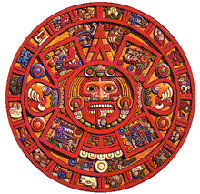Mexican archaeologists unearth monolith showing early calendar, decapitated women
Researchers said they have unearthed what may be one of the earliest calendar entries in Meso-America, a monolithic sculpture that suggests women held important status roles in pre-Hispanic culture.

The massive stone sculpture depicts two decapitated women with streams of blood or water flowing from their necks. Markings on top of the figures appear to depict an entry from, or part of, a 13-month lunar calendar, said archaeologist Guillermo Ahuja, who led the excavation of the monument.
"This would be the first depiction of a calendar or calendar elements in such an early time period," Ahuja said Thursday.
The monolith, which measures more than 8 meters (yards) and weighs about 20 tons, was found in March 2005 at the Tantoc ruins in San Luis Potosi state, near Mexico's northern Gulf coast, by construction workers.
The stone's glyph-like inscriptions were carved sometime around 700 B.C., likely by the Huasteco culture and may predate other early calendars by hundreds of years, Ahuja said.
That theory has not yet been proven or published in scientific journals; its feasibility depends on whether the markings really are glyphs or calendar entries, and whether they really are that old.
"The earliest calendrical inscriptions that we know of for certain come from Oaxaca ... and they date to no earlier than 500 B.C.," said E. Wyllys Andrews, an archaeology professor at Tulane University. "Finding this in the Huasteca (region) at 700 B.C. would be a real stretch."
The lunar calendar has frequently been associated with female figures. The site where the stone was found was also a sacred area and burial ground occupied by the graves of 14 females, whose pottery offerings depicted women.
"This suggest that women played very important roles, not only as priestesses, but politically as well," Ahuja said.
Luciano Cedillo, director of Mexico's National Institute of Anthropology and History which employs Ahuja called the find "important and surprising."
In many pre-Hispanic cultures, prisoners of war or sacrificial victims were often decapitated or flayed. Most depictions show males, but some cultures depicted decapitated females as a symbol of fertility.
The blood or water flows from the necks of the two women in all directions, and into the belly button of a third, central figure depicted as an almost skeletal figure, neither male nor female.
The announcement came four days after archaeologists in Mexico City discovered a smaller monolith near Mexico City's main square, but the sculpture on that monument cannot yet be read because much of the stone remains buried, reports AP.
The smaller monolith it measures about 3.5 meters (yards) on its longest side was probably erected in the closing years of the Aztec empire, between 1502 and 1521, when the Spaniards conquered Mexico.
Cedillo said the earth covering the stone could be removed by sometime next week, at which point experts could examine and evaluate the carvings, which some researchers believe could be dedicated to Tlaloc, a rain god.
Tlaloc is also depicted on one of two small altars discovered near the monolith in Mexico City's Templo Mayor ruins, the main worship site for the Aztecs, who founded the city in 1325. The other altar depicts a minor deity, possibly related to farming.
Subscribe to Pravda.Ru Telegram channel, Facebook, RSS!


